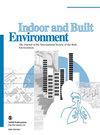估算室内环境中长期咳嗽后的飞沫大小和数量分布
IF 2.9
3区 工程技术
Q2 CONSTRUCTION & BUILDING TECHNOLOGY
引用次数: 0
摘要
我们开发了一种经验相关性和一套机器学习(ML)模型,用于估算在不同相对湿度(RHs)、气温和室内环境中不同位置的咳嗽后较长时间内的水滴大小和数量分布。实验涵盖了 20%-80% 的相对湿度和 21 °C-26 °C 的气温。在距离咳嗽源 2 米的范围内,记录了 4 个大小分级(0.3-0.5、0.5-1、1-3 和 3-5 μm)的飞沫数量分布,持续时间为 70 分钟。针对每个大小分区训练了不同的 ML 模型,包括决策树、随机森林和人工神经网络,以预测相关的计数分布。在这些模型中,随机森林的性能略胜一筹。随机森林模型的判定系数在 0.912 至 0.989 之间,表明特征与响应变量之间存在稳健的相关性。0.3-0.5 μm 水滴的计数分布与时间、相对湿度和沿咳嗽方向的距离之间建立了经验相关性。ML 模型和相关性都准确地预测了趋势和分布,为验证计算模拟和室内环境控制系统提供了宝贵的数据,从而降低了病毒传播的风险。本文章由计算机程序翻译,如有差异,请以英文原文为准。
Estimating droplet size and count distributions over a prolonged period of time following a cough in indoor environments
An empirical correlation and a set of machine learning (ML) models were developed to estimate droplet size and count distributions over an extended duration after a cough at different relative humidities (RHs), air temperatures and locations within an indoor environment. Experiments covered RHs of 20%–80% and air temperatures of 21 °C–26 °C. Droplet count distributions for 4 size bins (0.3–0.5, 0.5–1, 1–3 and 3–5 μm) were recorded for 70 min within the distance of 2 m from the cough source. Different ML models, including decision tree, random forest and artificial neural network, were trained for each size bin to predict the associated count distribution. Amongst these models, random forest showed a slight superiority in performance. The coefficient of determination for the random forest models ranged from 0.912 to 0.989, indicating robust correlations between the features and the response variables. An empirical correlation was established linking the count distribution of 0.3–0.5 μm droplets to time, RH and distance along the cough direction. Both ML models and the correlation accurately predicted the trends and the distributions, providing valuable data for validating computational simulations and informing indoor environment control systems to reduce the risk of virus transmission.
求助全文
通过发布文献求助,成功后即可免费获取论文全文。
去求助
来源期刊

Indoor and Built Environment
环境科学-工程:环境
CiteScore
6.40
自引率
25.00%
发文量
130
审稿时长
2.6 months
期刊介绍:
Indoor and Built Environment publishes reports on any topic pertaining to the quality of the indoor and built environment, and how these might effect the health, performance, efficiency and comfort of persons living or working there. Topics range from urban infrastructure, design of buildings, and materials used to laboratory studies including building airflow simulations and health effects. This journal is a member of the Committee on Publication Ethics (COPE).
 求助内容:
求助内容: 应助结果提醒方式:
应助结果提醒方式:


